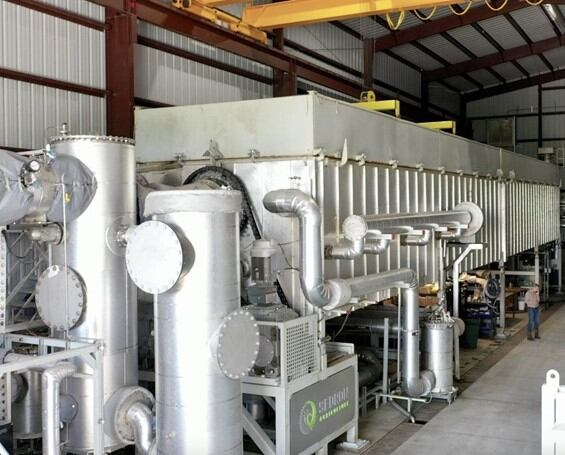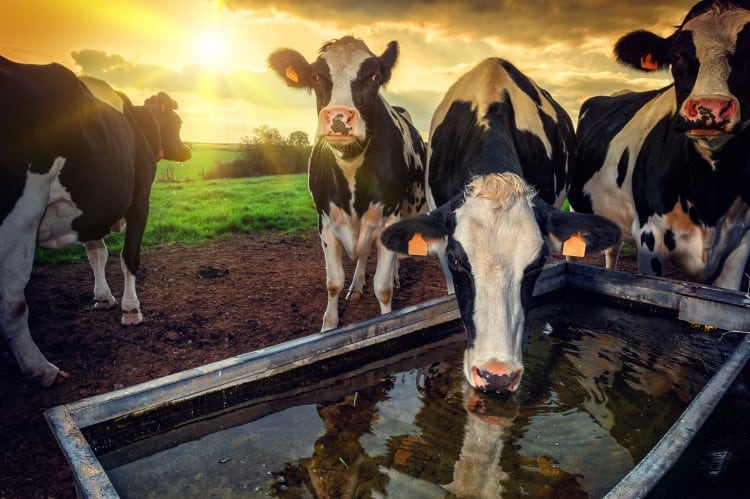The technology comprises the Varcor system, developed by manufacturer Sedron Agriculture in a joint venture with Natural Prairie Dairy . It is based on the process of mechanical vapor recompression to separate manure into three products – clean water that can be used as drinking water for cows and to water crops; aqueous ammonia, and dry phosphorus powder/fertilizer. The process is a ‘very efficient’ form of thermal evaporation, we were told, and is similar to how dry milk powder is produced. “The energy source is electricity and, generally, is lower cost than existing disposal methods. Given that a lagoon is no longer required, methane and other greenhouse gas emissions are greatly reduced,” Donald DeJong, co-owner and CEO of Natural Prairie Dairy, told us.
Here’s how it works: as liquid slurry enters the machine, solid and liquid fractions are separated through thermal evaporation; the dry solids are heated and removed, while the vapor portion is sent to a compressor, where it undergoes mechanical recompression. The product of that step – compressed vapor – is then used as the heat source to fuel the evaporation that processes the dry fertilizer. Meanwhile, the low-boiling-point components, such as ammonia, are concentrated and extracted separately, and the clean water is distilled and harvested from the saturated liquid.
“Inside the machine, the fractions of manure are separated using varying boiling points and a patented distillation process,” DeJong explained. “Liquid manure slurry enters the system and the solid and liquid fractions are separated through thermal evaporation. The resulting vapor is sent to a compressor, where it undergoes mechanical recompression. The compressed vapor is then used as the heat source for the evaporation process. The steam and its heat are re-circulated throughout the system to keep it all running. The ammonia gas is condensed into a liquid product - a stable ammonium product, which is easier to store and use for crops.”
Meanwhile, the water that comes from the system is pathogen-free and ready to be re-used on the farm. “The water that comes from the Varcor is suitable for irrigation or cattle drinking water,” DeJong told us. “It is also important to note that the Varcor kills all bacterial pathogens.”
“Adopting a fully closed-loop system has allowed us to become more self-sufficient in a tumultuous market. We are less vulnerable to drought challenges because we recycle wastewater, and the liquid and dry fertilizers help mitigate rising costs and low supply.”
It’s worth noting that the system is suitable for farm operations with a minimum of 3,500-head herds to make this a financially-viable investment. The machine can process up to 90 gallons of manure per minute, we were told. “It is designed to be plug-and-play so that all components can be pre-tested, shipped, then assembled on farm,” said DeJong, adding that ‘the machinery is very technical, but with training, it’s easy to use.’ “Scaling the system can seem costly, but when producers consider the money that currently goes towards managing, hauling and spreading manure from lagoons, they’ll find that they can make more money managing manure with the Varcor,” said DeJong.

Natural Prairie Dairy is now in its fifth year of utilizing the system at both its Texas Panhandle dairy and a satellite facility near Lake Village, Indiana. Both dairies are certified organic and employ the components processed by the Varcor in their cropping systems. The water fraction has been utilized for cattle drinking water and crop irrigation. “Natural Prairie Dairy uses the NPK powder and the ammonia on our corn and alfalfa fields as a concentrated, weed-free, organic fertilizer,” DeJong explained. “Both of these fertilizer outputs have been approved for use under the OMRI and USDA organic standards.
“As a farm that grows a lot of our own animal feed and raises animals in a dry environment, the fertilizer and water from the Varcor cut costs significantly. In addition to cost savings, the Varcor allows us to reduce greenhouse gas emissions by avoiding manure application on fields and manure storage in lagoons,” he added.
In addition to the Natural Prairie Dairy installations, Sedron Technologies – parent company of Sedron Agriculture - has installed a system in Washington State that processes human biosolids and another system that processes liquor waste. The firm is also in the process of installing 13 additional Varcor systems on dairies in Indiana, Texas, and Wisconsin, we were told. The long-term goal is to have a nationwide presence that extends into other livestock sectors.

